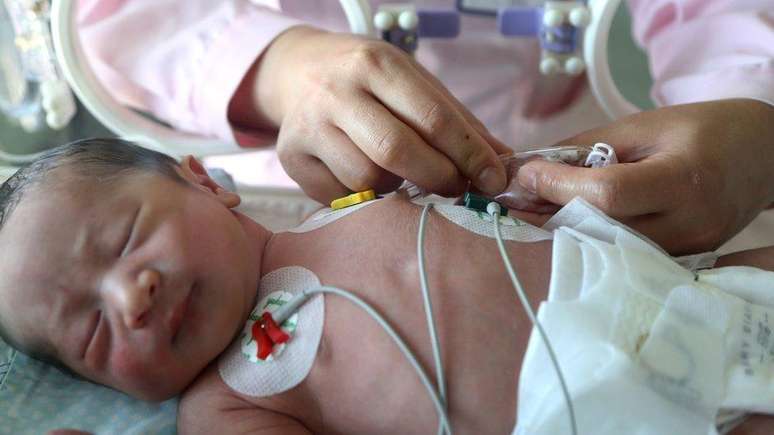The goal is to have a larger population that can work and produce more goods and services, driving economic growth.
Falling birth rates are a major concern for some of Asia’s largest economies.
Governments across the region are spending hundreds of billions of dollars trying to reverse the trend. But will it work?
Japan began introducing policies to encourage couples to have more children in the 1990s. South Korea started doing this in the 2000s, while Singapore’s first fertility policy dates back to 1987.
China, which has seen its population decline for the first time in 60 years, has recently joined the club.
While it’s hard to quantify exactly how much these policies have cost, South Korean President Yoon Suk-yeol recently said his country has spent more than $200 billion (R$1 billion) over the past 16 years trying to increase its population. .
Despite this, South Korea broke its own record for the lowest fertility rate in the world last year, with the average number of expected children per woman falling to 0.78.
In Japan, which had the lowest number of births last year (fewer than 800,000), Prime Minister Fumio Kishida pledged to double its 10 trillion yen (R$360 billion) budget for health-related policies. childhood, which is just over 2% of the country’s gross domestic product (GDP, sum of goods and services).
Globally, although there are more countries seeking to reduce birth rates, the number of those wanting to boost fertility has more than tripled since 1976, according to the latest United Nations report.
So why do these governments want to increase their population?
In other words, having a larger population that can work and produce more goods and services, driving greater economic growth.
And while a larger population can mean higher costs for governments, it can also translate into higher tax revenues.
Furthermore, many Asian countries are aging rapidly. Japan leads the pack, with nearly 30% of its population now over 65 – some other nations in the region aren’t far behind.
On the other hand, in India, which just overtook China as the world’s most populous nation, more than a quarter of its population is between 10 and 20 years old, giving its economy enormous growth potential.
And as the share of the working-age population decreases, the cost and burden of caring for the non-working population increases.
“Negative population growth impacts the economy, and coupled with population aging, it becomes virtually impossible to support the elderly,” says Xiujian Peng of Victoria University in Australia.
Most of the measures across the region to raise birth rates were similar: aid for new parents, subsidized or free education, extra childcare, tax breaks, and extended parental leave.

Effective measures?
But do these measures work?
Data from Japan, South Korea and Singapore over the past few decades show that attempts to increase their populations have had little impact. Japan’s Ministry of Finance has released a study saying the policies have backfired.
It is a view shared by the United Nations.
“We know from history that the kind of policies we call population engineering, where they try to encourage women to have more children, just don’t work,” Alanna Armitage of the United Nations Population Fund (UNFPA) tells the BBC.
“We need to understand the underlying causes of why women are childless, and that is often women’s inability to reconcile work life with family life,” she adds.
In Scandinavian countries, however, fertility policies have worked better than in Asia, according to Peng.
“The main reason is that they have a good welfare system and the cost of raising children is lower. Gender equality is also much more balanced than in Asian countries.”
Asian countries rank lower than the World Economic Forum’s global gender gap report
There are also major questions about how to finance these costly measures, especially in Japan, which is the world’s most leveraged developed economy.
Options being considered in Japan include selling more government bonds (one of the ways a country finances itself), which means increasing its debt, sales taxes, or tinkering with Social Security amounts.
The first option adds a financial burden to future generations, while the other two would hit already struggling workers, which could convince them to have fewer children.
But Antonio Fatás, an economics professor at INSEAD in Barcelona, Spain, says if these policies work, countries need to invest in them.
“Fertility rates didn’t go up, but what if there was less support? Maybe they were even lower,” she says.
Governments are also investing in other areas to prepare their economies for population contraction.
“China has invested in technologies and innovations to offset the shrinking workforce, in order to mitigate the negative impact of the shrinking population,” Peng says.
Also, while it remains unpopular in countries like Japan and South Korea, lawmakers are debating changing their immigration rules to try to attract younger workers from overseas.
“Globally, the fertility rate is declining, so it will be a race to attract young people to work in their country,” Peng adds.
Source: Terra
Rose James is a Gossipify movie and series reviewer known for her in-depth analysis and unique perspective on the latest releases. With a background in film studies, she provides engaging and informative reviews, and keeps readers up to date with industry trends and emerging talents.


![Such a wonderful sun in advance: Pablo’s departure? … What are you waiting for from April 21, 2025 to 25 to 25 [SPOILERS] Such a wonderful sun in advance: Pablo’s departure? … What are you waiting for from April 21, 2025 to 25 to 25 [SPOILERS]](https://fr.web.img4.acsta.net/img/b5/72/b572dbc47e83e76e01c036964b86642f.jpg)




